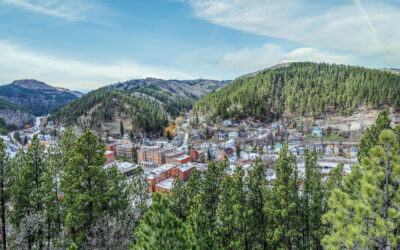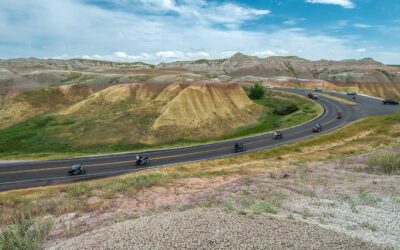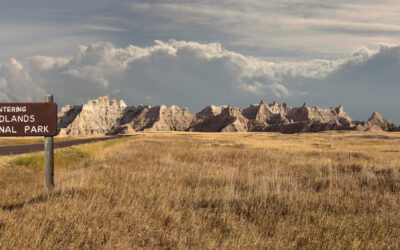Wind Cave National Park is a hidden treasure nestled within the Black Hills, offering a fascinating journey through one of the world’s most complex cave systems. This article delves into the geological, ecological, and historical significance of the park’s underground marvels and showcases the myriad activities available above ground. From the intricate cave formations to the rich biodiversity and the park’s role in American history, Wind Cave National Park promises an adventure that is both educational and awe-inspiring.
Key Takeaways
- Wind Cave National Park features a vast underground network with over 32 miles of explored passageways, highlighting geological history that spans millions of years.
- The park’s unique ‘Volcano Room’ serves as a natural auditorium, demonstrating the immense scale and acoustic properties of the cave system.
- Biodiversity thrives both above and below ground, with the park protecting various ecosystems, including rare and endangered species, sustained by the Green River.
- Diamond Caverns within the park are renowned for their sparkling calcite crystals and historic significance, once used for saltpeter mining during the Civil War.
- Visitors can enjoy a range of above-ground activities such as hiking, bird-watching, and canoeing, making the park a destination for diverse outdoor adventures.
Journey into the Depths: The Geological Wonders of Wind Cave
A Timeline of Earth’s Artistry
Wind Cave National Park is a testament to the Earth’s dynamic history, encapsulating millions of years of geological evolution beneath its surface. The cave’s intricate passageways and formations tell a story of natural artistry and transformation over time. Visitors can experience this first-hand through guided tours that illuminate the cave’s ecological significance and its intersection with human history.
The cave system, stretching over 32 miles, ranks as one of the longest in the United States. Its complex chambers, adorned with stalactites and stalagmites, are a marvel to behold. The ‘Volcano Room,’ a grand underground expanse with a soaring 400-foot ceiling, exemplifies the cave’s grandeur and is a highlight for many explorers.
Here’s a glimpse into the timeline of Wind Cave’s formation:
- Formation of limestone layers: The foundation of the cave’s structure.
- Erosion and water flow: Carving out the cave’s passageways.
- Mineral deposits: Giving rise to the stunning stalactites and stalagmites.
- Human discovery: The intersection of natural wonder with cultural history.
The Volcano Room: Nature’s Own Auditorium
Tucked within the labyrinthine expanse of Wind Cave National Park, the Volcano Room stands as a geological masterpiece, a testament to the park’s subterranean grandeur. This colossal chamber, with its soaring 400-foot ceiling, resembles a natural amphitheater, where the earth itself has sculpted an auditorium of staggering proportions.
The Volcano Room is not only a visual spectacle but also an acoustic wonder. Its unique structure allows for sound to reverberate in a way that transforms the cave into a venue for concerts and events, offering an experience that is both immersive and resonant. Visitors are often captivated by the natural acoustics, which enhance the sounds of music and spoken word, creating an unforgettable auditory journey.
Guided tours provide an opportunity to explore this underground marvel, where the geological narrative of the cave is unveiled. The tours highlight the intricate formations that adorn the Volcano Room, such as stalactites and stalagmites, and delve into the cave’s ecological significance. The experience is both educational and awe-inspiring, as it connects visitors to the ancient processes that continue to shape this dynamic subterranean landscape.
Stalactites to Stalagmites: Sculptures of Time
Wind Cave National Park offers a mesmerizing underground experience, where time is etched into stone. The cave’s geological history spans millions of years, with natural processes meticulously sculpting its interior into a gallery of stone masterpieces. Visitors can witness the slow yet persistent dance of mineral deposition that forms the iconic stalactites and stalagmites, each drop contributing to the cave’s evolving artistry.
The cave’s extensive system, one of the longest in the United States, is showcased through guided walking tours. These tours not only highlight the remarkable geology but also delve into the ecological significance and the human history intertwined with the cave’s existence. The ‘Volcano Room,’ a grand underground auditorium, is a testament to the cave’s vastness and the power of natural acoustics.
Below is a brief comparison of stalactites and stalagmites found within Wind Cave:
| Feature | Description | Formation Time |
|---|---|---|
| Stalactite | Hangs from the ceiling | Thousands of years |
| Stalagmite | Rises from the floor | Similar timeframe |
These formations, along with flowstone and other speleothems, create a surreal and enchanting underground landscape, inviting explorers to ponder the passage of time in one of South Dakota’s top attractions. The park’s dual nature, with its lush surface landscape and mysterious depths, offers a striking contrast that continues to draw visitors from around the world.
The Surface and Below: Biodiversity at Wind Cave National Park
From Hardwood Forests to Subterranean Rivers
Wind Cave National Park is a treasure trove of natural diversity, seamlessly transitioning from the lush hardwood forests above to the intricate network of subterranean rivers below. The park’s unique ecosystem supports a variety of plant and animal species, some of which are rare or endangered, creating a delicate balance between the surface and the underground.
The Green River, a vital waterway, meanders through the park, contributing to the scenic beauty and ecological significance of the area. It serves as a lifeline for the ecosystems within Wind Cave, ensuring the survival of numerous species and maintaining the natural harmony.
Visitors to Wind Cave National Park can experience the stark contrast between the above-ground splendor and the mysterious depths below. The park offers guided tours that delve into the fascinating history and ecology of this underground realm, providing an immersive experience for adventure seekers and nature enthusiasts alike.
Spotting the Rare and Endangered
Wind Cave National Park serves as a sanctuary for a diverse array of species, some of which are rare or endangered. Visitors have the unique opportunity to encounter these species, contributing to the park’s allure as a destination for wildlife enthusiasts. The park’s distinct ecosystems support a variety of habitats, from the prairie grasslands above to the subterranean passages below.
Among the rare flora and fauna, the park is home to species that have adapted to the unique conditions of the cave environment. These include cave-dwelling invertebrates and bats, which play a crucial role in the ecological balance. On the surface, the park’s mixed-grass prairie is a habitat for the endangered black-footed ferret, once thought to be extinct in the wild.
To appreciate the full extent of the park’s biodiversity, here’s a snapshot of some of the rare and endangered species found within its boundaries:
- Black-footed ferret (Endangered)
- Townsend’s big-eared bat (Special concern)
- Prairie falcon (Special concern)
- American bison (Historically significant, currently managed)
Conservation efforts are ongoing to protect these species and their habitats, ensuring that Wind Cave National Park remains a refuge for them for generations to come.
The Green River: A Lifeline for Ecosystems
The Green River, with its meandering flow through Wind Cave National Park, is more than just a picturesque backdrop; it’s an ecological powerhouse. Its waters are the lifeblood of the park’s diverse habitats, sustaining hardwood forests, wetlands, and the myriad of species that call these environments home. The river’s significance extends beyond its scenic charm, playing a pivotal role in maintaining the ecological balance and supporting both terrestrial and aquatic life.
The river’s ecosystem supports an array of wildlife, some of which are rare or endangered. The presence of clean, flowing water is crucial for these species, many of which are specially adapted to the unique conditions of the park. Here’s a glimpse into the biodiversity supported by the Green River:
- Hardwood forests that provide shelter and food for wildlife
- Wetlands that act as natural water filters and habitats for amphibians and birds
- Endangered species that rely on the river’s ecosystem for survival
Conservation efforts are key to preserving this vital artery of life. The park’s management practices aim to protect the water quality and natural habitats, ensuring that the Green River continues to thrive as a lifeline for the park’s ecosystems. As visitors explore the wonders of Wind Cave National Park, they are encouraged to respect and contribute to the conservation of this essential resource.
Diamond Caverns: A Sparkling Subterranean Experience
Goliath and Frozen Waterfall: Nature’s Masterpieces
Wind Cave National Park is home to some of the most extraordinary geological formations on the planet. Among these, Goliath stands as a testament to the slow yet powerful forces of nature. This colossal stalagmite, one of the largest known to exist, towers within the cave like a silent guardian of the underground realm. Its immense size and grandeur are a source of fascination for geologists and visitors alike.
Adjacent to Goliath, the Frozen Waterfall formation captivates the imagination with its resemblance to a cascade frozen in time. The delicate appearance of this rock formation belies the strength and endurance it represents, having withstood the test of time to become a highlight of the cave’s natural artistry. Tours through the cave offer a close-up view of these wonders, allowing visitors to appreciate the intricate details and the sheer scale of these subterranean marvels.
While exploring Wind Cave’s depths, visitors can also consider venturing to nearby attractions that complement the experience. For instance, the Jewel Cave National Monument offers an additional underground adventure with over 202 miles of passageways, making it one of the longest caves in the world. It’s a perfect addition to the caving enthusiast’s itinerary, with guided tours that reveal its own unique geological features.
Echoes of History: The Caverns’ Role in American Heritage
The historical tapestry of Diamond Caverns is as intricate as its geological formations. During the American Civil War, the caverns were a pivotal source of saltpeter, essential for gunpowder production, leaving behind traces that whisper tales of the past to today’s visitors. The caverns’ multifaceted history extends beyond their natural splendor; they have witnessed various chapters of American life, from the Civil War to Prohibition, when they transformed into a speakeasy.
Today, the Diamond Caverns invite explorers to traverse time and rock. Guided tours offer a dual narrative, intertwining the marvels of stalactites and stalagmites with stories of the caverns’ influence on regional history. Discovered in 1859 and later named for the calcite crystals that mimic diamonds, these caverns have been a beacon for those drawn to the subterranean world.
Here’s a glimpse into the historical significance of Diamond Caverns:
- Source of saltpeter during the Civil War
- Speakeasy during Prohibition
- Venue for the Bluegrass Underground concert series
- Named ‘Diamond Caverns’ for the sparkling calcite crystals
Whether you’re a history buff or a geology enthusiast, the Diamond Caverns present a unique journey through time, offering insights into the forces that have shaped both the earth beneath us and the nation above.
Beyond the Caves: Exploring Cathedral Caverns State Park
While the subterranean wonders of Cathedral Caverns State Park are undoubtedly its main attraction, the park’s allure extends far beyond its cave system. Above ground, the park is a haven for outdoor enthusiasts, offering a variety of activities set against the backdrop of Alabama’s stunning natural beauty.
Visitors can immerse themselves in the picturesque woodlands through numerous hiking trails, each promising its own unique view of the park’s diverse landscape. For a more leisurely experience, picnic areas are scattered throughout, providing the perfect spots to relax and enjoy the serene environment.
Here’s a quick guide to what you can expect at Cathedral Caverns State Park:
- Distance from Nashville: 139 miles
- Driving Time: 2.5 hours
- Notable Features: Massive stalagmites and stalactites
- Activities: Hiking, picnicking, cave tours
The park not only showcases the geological marvels below but also celebrates the rich tapestry of life above ground. It stands as a testament to the beauty hidden beneath the surface, echoing the intricate history and natural splendor of Alabama’s landscape.
Adventures Above Ground: Embracing the Park’s Natural Splendor
Hiking Trails and Bird-Watching Bliss
Wind Cave National Park’s hiking trails are a testament to South Dakota’s attractions, offering more than just a walk in the park. These trails are a gateway to discovering the state’s diverse natural landscapes, from the rolling prairies to the dense forests that cloak the Black Hills. Each path is an invitation to explore the park’s geological wonders and to immerse oneself in the serenity of the Tennessee countryside.
The park’s trails cater to all levels of hikers, ensuring that whether you’re seeking a leisurely stroll or a challenging trek, there’s a route that fits your needs. Here’s a quick guide to some of the popular trails:
- Rankin Ridge Nature Trail: A short, one-mile loop that offers panoramic views and a chance to spot wildlife.
- Lookout Point Trail: A moderate, three-mile hike leading to stunning vistas of the park’s mixed-grass prairie.
- Wind Cave Canyon Trail: An easy, 1.8-mile trail that follows an old railroad bed, perfect for bird-watching.
Bird-watchers will find themselves in a paradise, with opportunities to observe a variety of avian species, including the great blue heron and migrating waterfowl. The park’s rich biodiversity is a draw for those looking to connect with nature and witness the beauty of wildlife in their natural habitat. Educational programs complement the hiking experience, offering insights into the park’s ecological and historical significance.
Canoeing Along the Scenic Waterways
Wind Cave National Park’s waterways offer a serene and picturesque setting for canoeing enthusiasts. The park’s extensive network of rivers and lakes, including the vast 18,000-acre lake with over 400 miles of shoreline, provides a perfect backdrop for a day spent gliding across the water. Canoeing allows visitors to discover hidden coves, navigate through crystal-clear waters, and immerse themselves in the tranquil beauty of the surrounding landscapes.
The confluence of the Collins and Caney Fork Rivers serves as a peaceful retreat, where the sounds of cascading waterfalls and the sight of lush forests enhance the paddling experience. Anglers will find the cool waters of the Caney Fork River to be an angler’s haven, teeming with fish and framed by the rugged beauty of the Cumberland Plateau.
For those looking to extend their adventure, the park’s scenic byways offer additional attractions. The nearby Spearfish Canyon, for instance, is home to Bridal Veil Falls and other stunning waterfalls, making it an ideal complement to a day on the water. Here’s a quick guide to some of the must-see stops along the way:
- Klein Museum: Explore Native American artifacts.
- Dignity: of Earth and Sky statue: Marvel at this enormous work of art.
- Bridal Veil Falls: Experience the beauty of Spearfish Canyon’s waterfalls.
Picnicking Amidst the Greenery
After a day of exploring the underground marvels and hiking the scenic trails of Wind Cave National Park, there’s no better way to relax than by enjoying a picnic amidst the lush greenery. South Dakota boasts seven national parks and roughly 60 state parks and recreation areas, each offering its own unique blend of natural beauty and outdoor activities. Wind Cave National Park, with its serene landscapes and ample picnic areas, is a perfect spot to unwind and reflect on the day’s adventures.
The park provides designated picnic areas equipped with tables and grills, allowing visitors to prepare and enjoy their meals surrounded by the park’s natural splendor. Whether you’re looking to have a quiet meal with family or a lively gathering with friends, these facilities cater to all. Here’s a quick checklist to ensure you have everything for the perfect picnic experience:
- Picnic basket with utensils and plates
- Cooler with food and beverages
- Blanket or chairs for seating
- Sunscreen and insect repellent
- Trash bags for cleanup
Remember to follow the ‘Leave No Trace’ principles, keeping the park pristine for future visitors. As you savor your meal, keep an eye out for the park’s wildlife; deer, prairie dogs, and a variety of birds are common sights. Picnicking at Wind Cave National Park isn’t just a meal; it’s an opportunity to immerse yourself in the tranquility of nature and create lasting memories.






